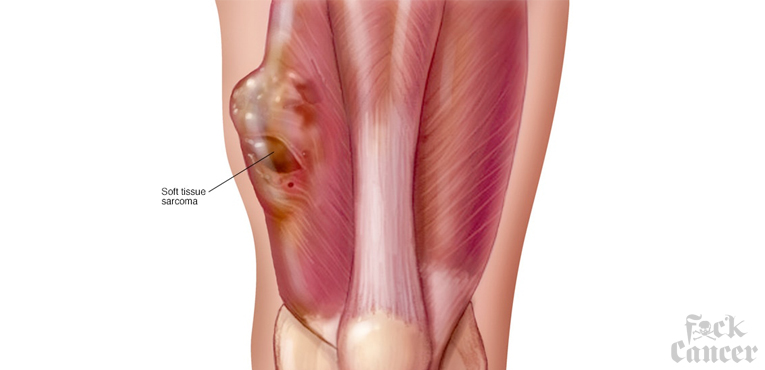
WHAT IS IT?
Soft tissue sarcoma (STS) is a rare type of cancer that begins in the tissues that connect, support and surround other body structures. This includes muscle, fat, blood vessels, nerves, tendons and the lining of your joints.
More than 50 subtypes of soft tissue sarcoma exist. Some types are more likely to affect children, while others affect mostly adults. These tumors can be difficult to diagnose because they may be mistaken for many other types of growths.
STS can occur anywhere in your body, but the most common types occur in the arms and legs, and in the abdomen. Surgical removal is the most common treatment, although radiation and chemotherapy also may be recommended — depending on the size, type, location and aggressiveness of the tumor.
In 2020, about 13,130 people (7,470 men and 5,660 women) will be diagnosed with STS in the United States.
An estimated 5,350 adults and children (2,870 males and 2,480 females) are expected to die of the disease in 2020.
Sarcomas are described as being localized, locally advanced, or metastaticwhen they are first found.
- Localized means the tumor is only in 1 area of the body.
- Locally advanced means the tumor involves or attaches to nearby tissues or organs. This often means it is not possible to remove the tumor because of its location, size, or the organs it involves.
- Metastatic means the sarcoma has spread to parts of the body far away from where the sarcoma started.
SYMPTOMS
A soft tissue sarcoma may not cause any signs and symptoms in its early stages. As the tumor grows, it may cause:
- A noticeable lump or swelling
- Pain, if a tumor presses on nerves or muscles
When to see a doctor
Make an appointment with your doctor if you have:
- A lump that is increasing in size or becomes painful
- A lump of any size that’s located deep within a muscle
- Recurrence of a lump that’s been removed
CAUSES
In most cases, it’s not clear what causes soft tissue sarcoma.
In general, cancer occurs when cells develop errors (mutations) in their DNA. The errors make cells grow and divide out of control. The accumulating abnormal cells form a tumor that can grow to invade nearby structures and the abnormal cells can spread to other parts of the body.
The type of cell that develops the genetic mutation determines what type of soft tissue sarcoma you have. For example, angiosarcoma begins in the lining of blood vessels, while liposarcoma arises from fat cells. Some types of soft tissue sarcoma include:
- Angiosarcoma
- Dermatofibrosarcoma protuberans
- Epithelioid sarcoma
- Gastrointestinal stromal tumor (GIST)
- Kaposi’s sarcoma
- Leiomyosarcoma
- Liposarcoma
- Malignant peripheral nerve sheath tumor
- Myxofibrosarcoma
- Rhabdomyosarcoma
- Solitary fibrous tumor
- Synovial sarcoma
- Undifferentiated (pleomorphic sarcoma)
RISK FACTORS
Factors that may increase your risk of sarcoma include:
- Inherited syndromes. A risk of soft tissue sarcoma can be inherited from your parents. Genetic syndromes that increase your risk include hereditary retinoblastoma, Li-Fraumeni syndrome, familial adenomatous polyposis, neurofibromatosis, tuberous sclerosis and Werner syndrome.
- Chemical exposure. Being exposed to certain chemicals, such as herbicides, arsenic and dioxin, may increase the risk of soft tissue sarcomas.
- Radiation exposure. Previous radiation treatment for other cancers can increase the risk of soft tissue sarcomas.
DIAGNOSIS
Because there are so many different types of soft tissue sarcoma, it’s important to determine the exact nature of each tumor so that the best treatments can be chosen.
Imaging tests
To evaluate the area of concern, your doctor might employ:
- X-rays
- Computerized tomography scans
- Magnetic resonance imaging
- Positron emission tomography
Biopsy
If a soft tissue sarcoma is suspected, it’s often best to seek care at a medical center that sees many people with this type of cancer. Experienced doctors will select the best biopsy technique to ensure proper surgical treatment and planning. Options include:
- Core needle biopsy. Tiny tubes of tumor material can be obtained by this method. Doctors typically try to take samples from several sections of the tumor.
- Surgical biopsy. In some cases, your doctor might suggest surgery to obtain a larger sample of tissue or to simply remove a small tumor entirely.
In the lab, a doctor trained in analyzing body tissues (pathologist) examines the tissue sample for signs of cancer. The pathologist also analyzes the sample to understand the type of cancer and to determine whether the cancer is aggressive.
LATEST RESEARCH
Doctors are working to learn more about sarcoma, ways to prevent it, how to best treat it, and how to provide the best care to people diagnosed with this disease. The following areas of research may include new options for patients through clinical trials. Always talk with your doctor about the best diagnostic and treatment options for you.
- Immunotherapy. Immunotherapy comes in many forms. Immune checkpoint inhibitors have become the focus of a lot of research. These drugs are targeted monoclonal antibodies (proteins) that turn on immune responses in the body by taking the brakes off the immune system. The molecules that are blocked have names such as CTLA4, PD-1, PD-L1, OX40, LAG3, and TIM3. This approach has proved helpful in treating many cancers and in research studies about sarcomas.Chimeric antigen receptor (CAR) T-cell therapy uses white blood cells from a patient’s blood to destroy cancer cells. The patient’s cells are removed the patient and then changed in a laboratory so they have specific proteins called receptors. These receptors allow those T cells to recognize the cancer cells. The changed T cells are grown in large numbers in the laboratory and returned to the patient’s body. Once in the patient’s body, these T cells seek out and destroy cancer cells. This technique shows the most promise when there is a known target on the sarcoma, such as in synovial sarcoma and myxoid-round cell liposarcoma. Clinical trials are investigating this exciting but complex form of immunotherapy.Vaccines against specific sarcoma proteins or other molecules are also being studied, often in addition to immune checkpoint inhibitors.
- Improved drug delivery. Some chemotherapies are incorporated into fat molecules called liposomes to improve the absorption and distribution of the drug in the patient’s body. Other new ways to get a chemotherapy into a cancer cell are being studied. For example, chemotherapy can be attached to proteins, so the chemotherapy can enter into the cancer cells. In some cases, these proteins are antibodies that target, or bind to, a specific marker on a cancer cell, so the chemotherapy is delivered only to cancer cells and not to normal cells, which can improve effectiveness and decrease side effects.
- New drugs. New medications are being developed and tested that may be effective in treating some subtypes of STS. Learn more about the process of drug development and approval.
- Targeted therapy. As explained in Types of Treatment, several targeted therapies have been recently approved to treat specific types of sarcoma. This is an active area of research for sarcoma.A recent study examined using sorafenib (Nexavar) to treat a rare type of sarcoma called a desmoid tumor. Sorefenib is a tyrosine kinase inhibitor currently used to treat liver, thyroid, and kidney cancers. Of those who took sorafenib in the clinical trial, 87% had their disease stopped for more than 1 year. In this study, 18% of patients who took sorafenib had to stop taking the drug because of side effects.
- Targeted oncogene treatments. Drugs are being researched that may block 1 or more of the proteins found in tumor cells that help the tumor grow and spread.
- Tumor genetics. Researchers are learning that some sarcomas have unique genetic “fingerprints.” Understanding these fingerprints may help doctors make precise diagnoses, determine better treatments, and possibly better predict a patient’s prognosis. A number of cancer centers and companies now offer genetic tests of cancers to determine whether people with a sarcoma might benefit from newer treatments.
- Palliative care/supportive care. Clinical trials are underway to find better ways of reducing symptoms and side effects of current sarcoma treatments to improve comfort and quality of life for patients.
.
.
.
.
.
Cancer.net, Soft Tissue Sarcoma, https://www.cancer.net/cancer-types/sarcoma-soft-tissue, by Cancer.net Editorial Board, May 2019
fuck cancer, fxck cancer, f cancer, fuck cancer foundation, fxck cancer foundation, f cancer foundation, cancer awareness, cancer detection, cancer prevention
